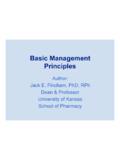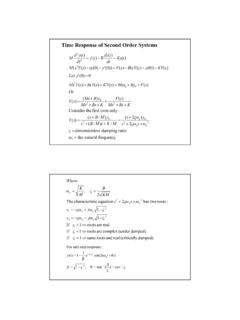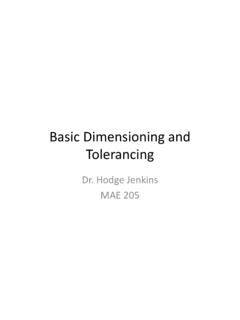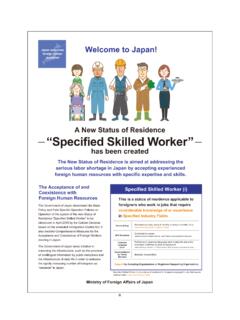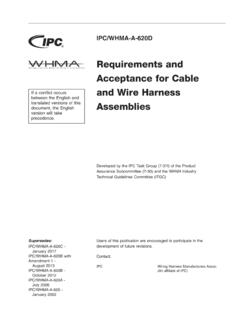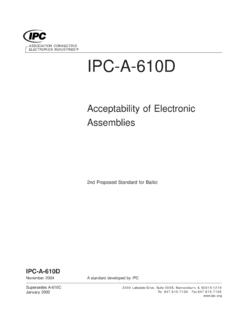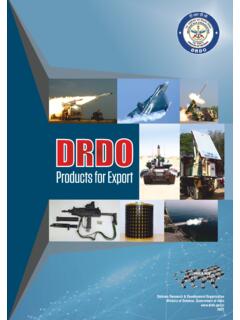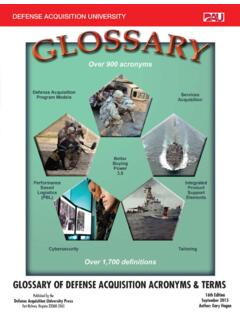Transcription of Engineering Standards What They are,
1 Engineering Standards What They are, Where &Why They re Used Dr. Hodge Jenkins Some Definitions: Standard: A standard is a document that defines the characteristics of a product, process or service, such as dimensions, safety aspects, and performance requirements . Code: Laws or regulations that specify minimum Standards to protect public safety and health such as codes for construction of buildings. Voluntary Standards are incorporated into building codes Specification: A set of conditions and requirements of precise and limited application that provide a detailed description of a procedure, process, material, product, or service for use primarily in procurement and manufacturing. Standards may be referenced or included in specifications. Technical Regulation: A mandatory government requirement that defines the characteristics and/or the performance requirements of a product, service or process (see also Regulation).
2 Why Standards and Codes? Standardization Parts from different vendors fit together Common design specs Consistent quality , Pipe wall thickness, schedule 40 Wire sizes, nail sizes, bolt sizes Safety & Legal Enforcement of Safety Building safety, fire prevention/protection Individual & Public Safety , Safe drinking water, safe nuclear plants Standards needed for function Functional Based 110V /60Hz or 220V/50Hz Piping (Schedule 40, 50, ..) Professional Society Based ANSI & ASME (Boiler & Pressure Vessel Code) IEEE communication Standards Parts Standardization Every mass produced product usually has a standard IEEE has many, many Standards for electronics DIN, ISO, ANSI for size, shapes, etc. US ANSI pipe Standards Diameters Thickness Materials Flange bolt patterns It s the law Legal requirements US & Internationally UL listed, CSA ANSI, JIS, ISO, DIN EPA, USNRC Code of Federal Regulations (CFR) Building codes, National Electrical Code, etc.
3 Some Background: The federal government is the largest single creator & user of Standards : more than 45,000 (by current estimates)! About 210 organizations are designated Standard Development Organizations (SDO s) Most Standards (about 90%) come from about 20 of these SDO s ASTM, ASME, IEEE, AISI (ASM), ASCE, MilStd (Mil Specs), are some of the most important SDO s Who makes Standards and Codes ? AIA Aerospace Industries Association of America AAI Aluminum Association, Inc AASHTO American Association of State Highway and Transportation Officials ACI American Concrete Institute AISC American Institute of Steel Construction AISI American Iron and Steel Institute ANSI American National Standards Institute ASCE American Society of Civil Engineers ASME American Society of Mechanical Engineers ASTM American Society for Testing and Materials AISE Association of Iron and Steel Engineers BOCA Building Officials and Code Administrators FAA Federal Aviation Administration ISO International Organization for Standardization MIL SPEC United States Military NIST National Institute of Standards and Technology OSHA Occupational Safety and Health Administration SAE Society of Automotive Engineers.
4 Professional Societies and Government Taking them Global! ANSI and ( National Committee (USNC)) are the clearing house for Standards and a founding member of ISO! Internationally there are Standards Organizations in every major Industrial Nation and several Umbrella Groups: International Organization for Standardization (ISO) International Electrotechnical Commission (IEC) International Telecommunication Union (ITU) How they re used: Standards are a COMMUNICATION tool that allows all users to speak the same language about products or processes They provide a Legal, or at least enforceable, means to evaluate acceptability & sale-ability of products and/or services They can be taught and applied globally! They, ultimately, are designed to protect the public from questionable designs, products and practices Thus they fall (in Engineering terms) into the MOM AND APPLE PIE area of our profession!
5 They teach us, as engineers, how we can best meet environmental, health, safety and societal responsibilities How did Standards develop? Selection from competing technologies Westinghouse AC power, Edison DC power Communications Standards Military requirements (Civil War) Failures ASME Boiler & PV Code (Boston Molasses Disaster, aka the Great Molasses Flood of 1919) Building fire codes Tacoma Narrow Bridge failure World Trade Center bombing .. Common, Everyday Standards Fasteners (#10-24 UNC bolt, M8 bolt) Plumbing sizes (Sch. 30, 40,..) Lumber sizes ( the real dimensions) Electrical Wire sizes (12, 14, 16 Gauge Electrical service 110 VAC, 60 Hz Air pollution controls: Car Inspections Building Codes Standards I have used professionally Westinghouse Nuclear ASME B&PV Code US CFR & TR Laws USPS R&D ANSI Drafting Standards Component specs Fisher Scientific UL & CSA Appliance design: ovens, centrifuges Molytek, Inc.)
6 , Lucent ISO, DIN, JIS Process & Product The National Institute of Standards and Technology (NIST), an agency of the Department of Commerce, conducted a three-year building and fire safety investigation to study the factors contributing to the collapse of the WTC Towers. September 11, 2001, was not the first time that tragedy helped to identify the need for Standards . More than a century ago, a great fire ravaged Baltimore, Maryland, for more than 30 hours in early 1904. The fire was reported first at the John Hurst and Company building at 10:48 on Sunday morning, February 7, and quickly spread. By 1:30 , units from surrounding communities were arriving. To halt the fire, officials tried to use a firewall, then dynamited buildings around the existing fire. These tactics, however, were unsuccessful and the fire continued until late afternoon on Mon., February 8. More than 1,231 firefighters were required to bring the blaze under control.
7 One reason for the fire's duration was the lack of national Standards in fire-fighting equipment. Although fire engines from Wilmington and Washington, DC, and cities as far away as Philadelphia, Atlantic City, and New York City responded, many were useless because their hose couplings failed to fit Baltimore hydrants. As a result, the fire burned over 30 hours, destroying 1,526 buildings spanning 70 city blocks. The National Fire Protection Association, which had been established in 1896 after a number of disastrous large-scale fires, then set about to develop uniform sprinkler systems and standard hose couplings. Go There! American National Standards Institute: An Introduction! Go There More than 10,000 National Standards in the USA alone Open Standards (process of developing) ANSI Learning About Them Why Standards Matter ANSI s first introductory level e-learning course is for those who may not be familiar with Standards , ANSI or the voluntary Standards and conformity assessment systems.
8 Standards Today and Tomorrow This course focuses on the national Standards systems and is an intermediate-level course that supplements basic Standards education. It provides more in-depth knowledge about the development, role and impact of domestic Standards on government, business, trade and professional associations, and includes a module for university faculty and students. The courses on this website complement ANSI s instructor-led education and training courses. The Impact of Standards on Business and Industry Roughly 80% of global merchandise trade is affected by Standards and by regulations that embody Standards Standards and conformity assessment programs play a key role in the transfer of technology, from the research and development stage, to production, and ultimately to a product's success in the marketplace. Strategic utilization of these Standards can simplify product development, reduce unnecessary duplication, lower costs, increase productivity, ensure safety, permit interchangeability, compatibility, and interoperability, enhance the acceptance of new products, maintain uniformity in product quality and much more.
9 Industry participation in the Standards development process is essential Standards in the news: ISO 9000 a quality standard used by business to say We are QUALITY (in US this has evolved into Q9001 as nationalized by AQS) UL rating used as an international safety rating (hence Standard) ISO 14000 the international Environmental Management Guideline (standard) and hence the de-facto product life cycle and sustainability standard for business, industry, and Engineering Design ANSI/ASME and international drafting Standards for Engineering drawings Even Clothes sizes are controlled by International Standards ! Building Codes are like Standards too (but are legally binding) : ASTM International : Materials Testing Standards Where they may Play into your Projects, Examples: (drafting Standard) found using a search engine available at ANSI with URL: .. And Internationally ISO 1101 Geometric Dimension and Tolerancing Standard NSSN Has Advanced Search Capabilities to find Standards that may be relevant to your project: Advanced Search is Thorough Try it for your project!
10 Take a Look at the Professional Societies Pages too for Standards ! This is a 20 page introduction to Standards available from ASME (for students) It available as a pdf document at: Many Quality Standards And Thinking Forward: ISO 140xx series of Environmental Standards : CRADLE TO-GRAVE Thinking for an Engineer Lest we also forget: Ethics in Engineering ! Health & Safety Stds. too! Finally: There s plenty here to consider but it s part of the professional Engineering job! Make Standards part of your Life-long Learning process check often for changes as they will effect your products and processes as an engineer or manager Find out what is appropriate for your project/product Include appropriate Standards a part of your specification As a test case, Each team MUST include a section in their team s PDR Document (brief but relatively through) on applicable Standards and specifications applicable to their project Which Standards are applicable How they were used
